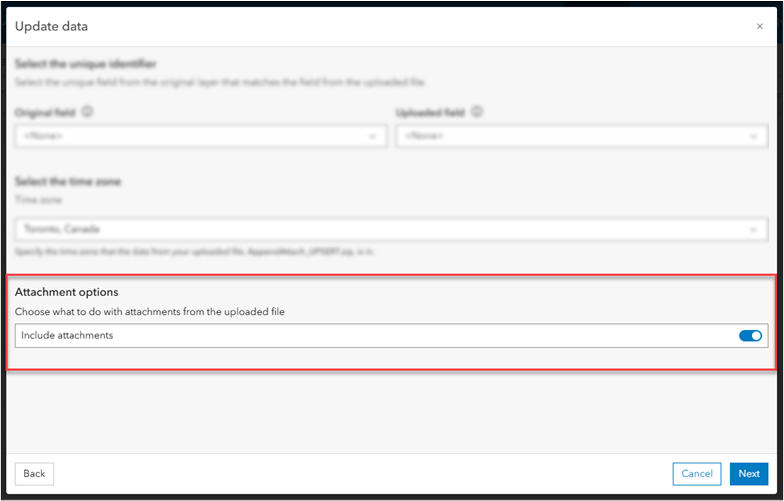With the June 2025 update of ArcGIS Online, you will now have the option to include attachments from your uploaded file when using the Update Data workflow. Whether you are adding new features, updating existing features, or both, the option to add new attachments will be available if certain requirements are met. This blog will cover the requirements to add attachments using Update data, an example workflow, and how attachments are evaluated when using Update data.


When do you see the option to include attachments?
The Include attachments toggle will appear in the Update Data workflow when the following conditions are met:
- The destination hosted feature layer has attachments enabled
- The uploaded file is a file geodatabase
- The uploaded file geodatabase contains attachments
Including attachments will add any associated attachments for both new and existing features.
When inserting features, any related attachments are also added. When updating features, only attachments that don’t already exist on the feature will be added. Regardless of the operation selected, any pre-existing feature attachments will never be updated or deleted.
Let’s take a closer look at this behavior with an example.

Example
Scenario: You are a field worker for a construction company in Boring, Oregon. Your task is to ensure the hosted feature service containing fire hydrant locations and inspection information (in the form of image attachments) is kept up to date. Let’s explore how you could do this using the various workflows available in Update data. If you need a refresher on the workflows and what they do, check out the blog here first before continuing.
Add
Add new point geometries representing fire hydrant assets to your existing hosted feature layer. The new features also have attachments. When “Include attachments” is toggled on, the features and their associated attachments in the uploaded file will be inserted into the existing feature layer.

Update
As a field worker, you are also responsible for inspecting existing hydrants and adding a new inspection image of each hydrant for the current year. Use the update workflow to update the attributes for pre-existing hydrant features (e.g., latest inspection date) while also adding in the most recent hydrant inspection image.
First, the existing feature is matched with the corresponding feature in the uploaded file according to the user-specified unique identifier field. If the feature in the uploaded file has an attachment that is not present on the existing feature, it will be added during the update operation. If the attachment is already present on the feature, it will not be added.

Add and update
Combine both the Add and Update workflows outlined above. Simultaneously insert new hydrant features and their attachments to your existing feature layer. Additionally, update attributes for existing hydrant features and insert the most recent inspection attachment image.


How do we determine if an attachment already exists on a feature?
Just like features, every attachment has a unique Attachment ID. If your hosted feature service contains a GlobalID field, each attachment will have an Attachment GlobalID, in addition to the Attachment ID.
The field type used as the unique identifier in the Update or Add and update workflows will determine what ID is used to determine if an attachment is already present on a feature or not. If a GlobalID field is used as the unique identifier, the Attachment GlobalID is used to match attachments between features. Otherwise, the Attachment ID will be used.
Looking at attachment information
There are two ways to view your attachment information, including the Attachment ID and Attachment GlobalID (if present). If your data is contained in a file geodatabase, you can add the .zip file into ArcGIS Pro and open the ATTACH table. Alternatively, you can query the attachments using the queryAttachments operation via the REST API.
We hope this helps you better understand how to use the Update data workflow to add attachments to your hosted feature services. To learn more about Update data and best practices for your hosted feature layers, add our Esri User Conference 2025 technical session to your calendars.



Commenting is not enabled for this article.